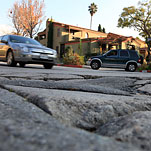DENVER — More than a decade after the Clinton administration proposed cordoning off tens of millions of acres of public lands in the West from road development, setting off a ferocious debate about wilderness and human uses of the land, a federal appeals court in Denver upheld the government’s authority on Friday in a sweeping rejection of the opposition.
Ruling Backs Forest Service in Limiting Roads in the Wild
By KIRK JOHNSON
Published: October 21, 2011
Connect With Us on Twitter
Follow @NYTNational for breaking news and headlines.
The unanimous ruling, issued by a three-judge panel of the United States Court of Appeals for the 10th Circuit, said a lower court had erred in finding for the State of Wyoming, the plaintiff in the case, and ordered that the rule be put into force nationally. Wyoming had argued that preventing road construction into or on national forests or other lands is a de facto wilderness designation, something that only Congress can do, and that the Forest Service had exceeded its own authority in trying to put the system into effect.
In a 120-page decision, the court said that full wilderness protection was far deeper than the mere banning of roads in certain places and that the Forest Service had broad jurisdiction in setting the balance of uses on the lands that it manages.
“The Forest Service did not usurp Congressional authority because the roadless rule did not establish de facto wilderness,” the court said in a decision written by Judge Jerome A. Holmes, who was nominated to the court by President George W. Bush.
Gov. Matt Mead of Wyoming, a Republican, said in a statement that the state was reviewing the ruling. It has the option of taking to the case to the Supreme Court or asking the full 10th Circuit to review the three-judge decision.
But supporters of the Clinton rule said they hoped that Friday’s ruling, which echoes a similar conclusion in 2009 by the Ninth Circuit Court of Appeals in California, would prove to be the last word on the subject.
“It’s a conclusive and definitive rejection of every complaint that the opponents have raised,” said Tim Preso, a lawyer for the environmental group Earthjustice. He has worked on the case, defending the roadless designation authority, since the first legal challenges in 2000. “And so now we have the Ninth Circuit and the Tenth Circuit Court of Appeals upholding the rule; that gives us a big leg up.”
What the public lands are basically for, how they are used and who is harmed or not by roadless designations are issues that have shifted significantly since 2000. Back then, the timber industry was a much bigger force than it is today and was among the first challengers.
Off-road recreational vehicle use, barely a blip a decade ago, has also emerged as a major issue in the debate over the environmental impact of human activity in national forests. Meanwhile, energy drilling has surged on public lands, creating new pressures that the earlier drafters and detractors of the rule had not envisioned.
The appeals court addressed many of those points in spurning the notion that new wilderness areas, with strict covenants limiting human impact, were being created. Roadless designation “will allow a multitude of activities including motorized uses” and “imposes no prohibition on mining or mineral-development activities,” the court said.













